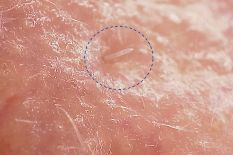New publication in Molecular Biology and Evolution explores life of human follicular mites

Microscopic mites that live almost our entire lives in our pores may soon become one with us entirely: An international research team including DOME member Alejandro Manzano Marín has conducted the first ever genome sequencing study of the Demodex folliculorum mite to explore the tiny parasite's way of life. The study has now been published in the journal Molecular Biology and Evolution.
Demodex folliculorum mites live in the facial hair follicles, including the eyelashes, and on the nipples of almost every human. They are about 0.3 mm long and feed on the sebum secreted by the cells in the pores. They become active at night and move between the follicles to mate. However, they cannot survive outside the pores. "Because of this close and permanent connection to humans, the mite has lost enormous size and numerous genes," explains Alejandro Manzano Marín. "Surprisingly, our study showed that the mites have many more cells when young than when they are adults. This contradicts the previous assumption that parasitic animals reduce their cell numbers early in development. Therefore, we conclude that the mites evolve from an external parasite to a permanent symbiont of humans," he reports.
For the study, Manzano Marín collaborated with colleagues from Bongor University (Wales), the University of Reading (England), the University of Valencia (Spain) and the National University of San Juan (Argentina). The researchers used genome sequencing to delve deep into the biology of the tiny organism. From the type, the size, the special arrangement of the genes, they were able to draw information about unusual body characteristics and ways of life of the tiny organisms. Because the mites exist in such isolation, they face no external threats, they do not have to compete to infest hosts, and they do not encounter other mites with different genes. The lack of contact with potential mates that could add new genes to their offspring could drive the mites into an evolutionary dead end and possibly to extinction.
picture (c): Alejandra Perotti / University of Reading
